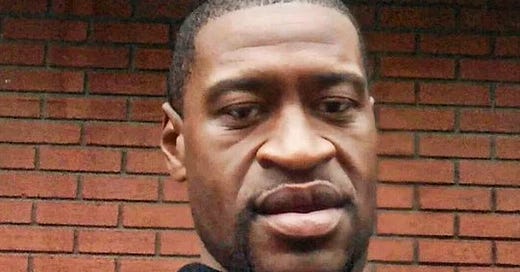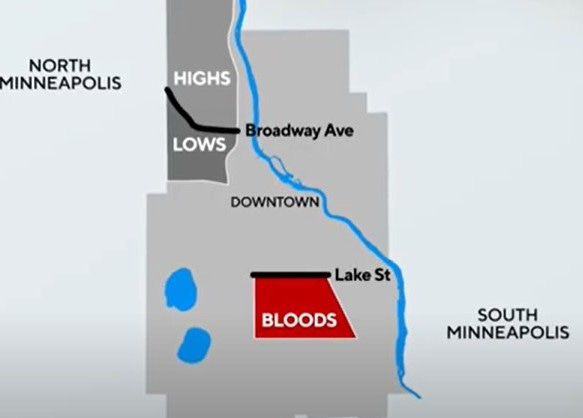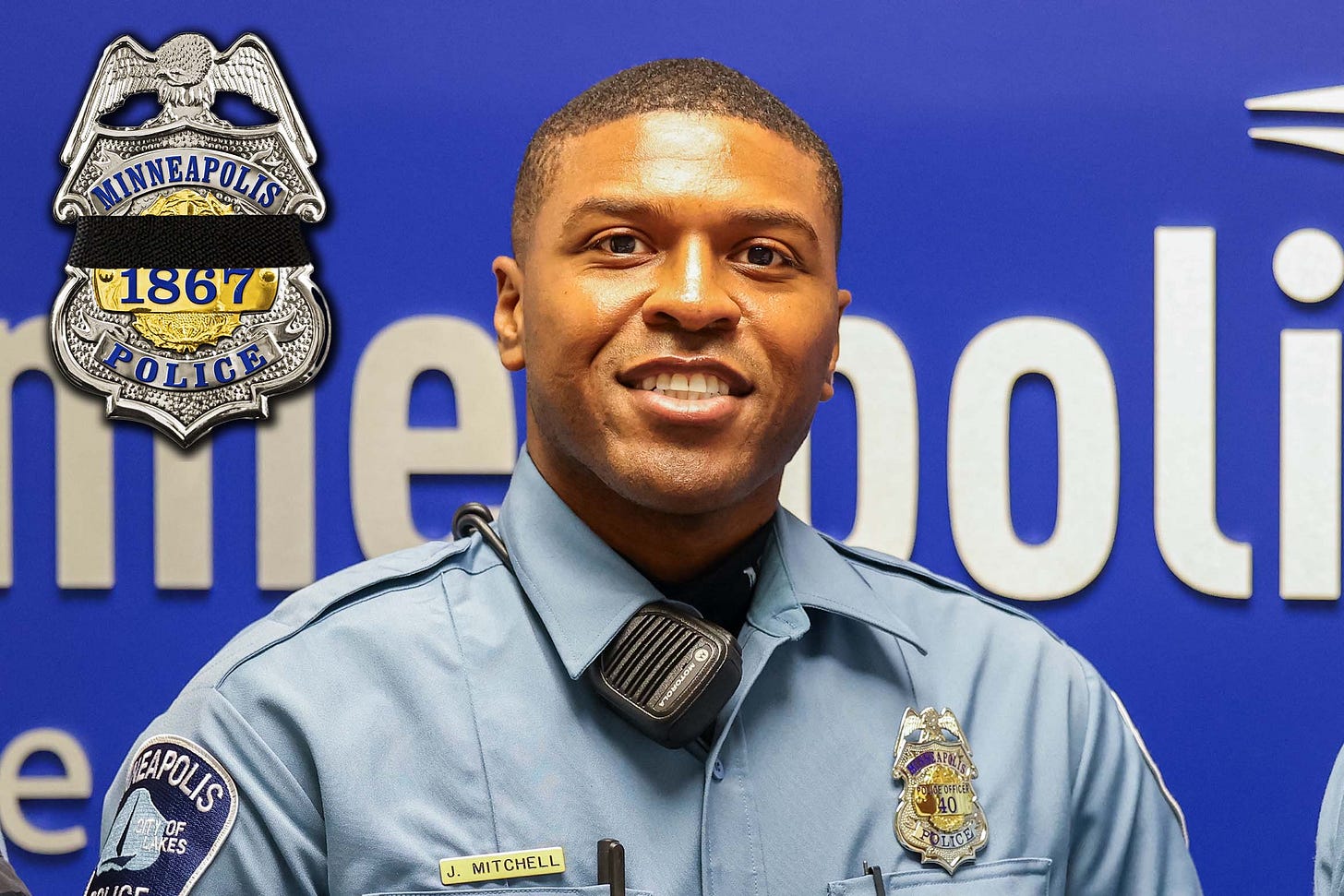On 25 May 2020 - five years ago tomorrow - George Floyd, an African-American man, was killed at the corner of Chicago Avenue and 38th Street in South Minneapolis.
A police officer, Derek Chauvin, was convicted of Floyd’s murder and a great deal has been said and written about that incident, and about policing in the United States, over the last five years.
But in today’s Substack I’m going to look at a subject which has got less attention - the gangs which have plagued Minneapolis in recent years.
On 25 June 2021 Chauvin, the officer who knelt on Floyd’s neck for nine minutes - causing his death - was jailed for 22 and a half years for second-degree murder.
During his trial a lawyer for Chauvin said it was “an error made in good faith" while Floyd, 48, was being arrested on suspicion of using a counterfeit note to buy a packet of cigarettes in a convenience store.
Floyd had famously cried out: “I can’t breathe” during the incident, and footage filmed by concerned passers-by went viral in the early summer of 2020, triggering to protests and riots across the US.
But I am not going to go into the politics of the incident or the Black Lives Matter movement. They have been well aired elsewhere.
I am instead going to drill down into some of the seedy facts about the city of Minneapolis.
On Monday (19 May) the chief of police in Minneapolis, Brian O’Hara, was being asked by reporters at a press conference if he knew anything about rumours that President Donald Trump was planning on pardoning Chauvin.
O’Hara said he had “no credible information” that was true - which was the line picked up by most of the reporters covering the press conference.
But O’Hara also said: “A frustration that I’ve had in the three years that I’ve been here is that we have very, very real challenges around crime in this city and ensuring that we’re able to provide safety.”
He said having an “effective police department” was “absolutely necessary” to tackle the city’s crime problem.
O’Hara said: “I have felt like at times that it’s controversial that policing in of itself is essential…for so many of our residents who are hardest hit by crime and violence in recent years.”
So I’m going to look in this Substack at some of those crime problems, and specifically the gangs, which have been ruining the lives of many people in Minneapolis in the last five years, or in many cases a lot longer.
But before I do that I want to briefly paint a picture of the city and give a little historical, political and racial context.
Minneapolis was founded in 1856, two years after neighbouring St Paul and they eventually became Minnesota’s “Twin Cities”.
In the 1970s the hit TV comedy The Mary Tyler Moore Show was set in Minneapolis and Rhoda, the eponymous character from the spin-off series used to joke:
"I came to Minneapolis because of the cold. I figured if I was frozen I'd keep better.”
But the city has a dark history of bigotry, just under the surface.
At one time it was dubbed the “anti-Semitism capital” of America and in the 1920s it was also home to the Ku Klux Klan.
According to this fascinating article on the Minnesota Realtors blog - not normally a source of revolutionary content - Minneapolis introduced “racial covenants” in the 1910s and they soon spread across the Twin Cities.
They barred people of “Chinese, Japanese, Moorish, Turkish, Mongolian, Negro or African blood or descent” from owning property in many neighbourhoods.
In the 1930s a more subtle tool was created - redlining.
Created by the Federal Housing Administration as a way of risk assessing government-backed mortgages, it soon became a way of racially segregating areas.
People of colour - who had largely moved to Minneapolis from the impoverished Deep South in the 80 years after the end of slavery - were classified as high risk by the FHA, and could therefore not buy the new houses being built in the 1930s.
Consequently African-Americans ended up ghettoised in several less appealing neighbourhoods - the Southside, the Near North, and Seven Corners.
Seven Corners and the Near North were small neighbourhoods just north of downtown, while Southside is a larger area, between East 34th Street and 46th Streets and between Nicollet Avenue and Chicago Avenue.
George Floyd was killed outside a Cup Foods store in the Southside, after he offered a counterfet $20 bill to cashier Christopher Martin.
Martin told his story to The Guardian in May 2021, and said: “I allowed myself to feel guilty for a very long time before the trial happened. I just kept replaying that decision in my head. What if I would have just told him he couldn’t buy the cigarettes?”
The intersection of East 38th Street and Chicago Avenue has been christened George Floyd Square.
For about a year after Floyd’s death, the roads were sealed off by protesters and the area was - as you can imagine - very hostile to the police.
A source in Minneapolis tells me that in April 2021 a woman was pushed out of a window on the corner of 38th Street and Elliott Avenue and suffered a number of cuts during a domestic incident. She called 911 and was asked to meet first responders a block away.
But let me tell you about the city’s gangs.
Southside - where George Floyd Square is - was the territory of The Bloods, part of the infamous network who were founded in Los Angeles and who consider The Crips to be their enemies.
As everyone on the streets knows, The Bloods wear red clothes and bandannas while The Crips were blue.
But there are no Crips in Minneapolis.
Instead there are two gangs - both of whom from North Minneapolis - called The Highs and The Lows.
As you can see from the map below, the boundary is Broadway Avenue, or West Broadway Avenue as it is sometimes known. The Highs run the area to the north, and The Lows are to the south.
For year The Highs, The Lows and The Bloods have dominated crime in these areas of Minneapolis.
In the wake of the George Floyd scandal, there was - as you may remember - a popular movement to “Defund The Police”.
Indeed a majority of Minneapolis City Council supported the idea.
They talking of beginning “the process of ending the Minneapolis Police Department” and said they would move towards a “police-free future.”
God only knows how that would have played out for the people of the crime-ridden areas of inner city Minneapolis.
In the event a proposal to replace the police with a “department of public safety” was rejected by the electorate and the Minneapolis Police Department’s budget grew from $181 million to $210 million in 2023.
In May 2023 the Department of Justice arrested 45 members of The Bloods and their rivals The Highs.
On 23 April 2025 Keon “KenKen” Pruitt, 22, Dantrell Johnson, 32, and Gregory Hamilton, 29, were convicted under RICO legislation of racketeering and membership of The Highs, and of involvement in the August 2021 murder of rival Darryl Wells.
Their trial heard that on 7 August 2021, a prominent member of The Highs was shot and killed by a member of The Lows at the Winner gas station, a popular Highs hangout.
The following day Pruitt, Johnson and Hamilton - all members of The Highs or one of its sub-gangs, attended a memorial for the dead man, where guns were handed out and threats made against The Lows.
Later that day, Johnson and Hamilton drove to Wally’s Foods, a Lows hangout, and shot one of their opponents, who survived.
Two hours later the trio drove to Skyline Market, another Lows hangout but mistakenly picked out Wells, who ran from the store and into the street.
Two juveniles who got out of a stolen Porsche which Pruitt was driving, chased Wells into a nearby alley and shot him eight times.
Acting U.S. Attorney Lisa D. Kirkpatrick said: “Minneapolis criminal street gangs have inflicted devastating harm on our community for far too long.”
“Three years ago, the U.S. Attorney’s Office announced our federal violent crime initiative to address the skyrocketing and completely unacceptable rates of violent crime in Minnesota,” she said.
“Since then, we have brought large RICO cases against three criminal street gangs—charging them as the violent enterprises they are,” added Kirkpatrick.
Now if you will forgive me, I’m a sucker for a good nickname.
So let me tell you about Nathan Walz, 35, who was convicted in August 2023 of possession with intent to distribute methamphetamine, being a felon in possession of a firearm, and possession of a firearm in furtherance of a drug trafficking crime.
A member of The Bloods, his nicknames include “Fat Nate”, “Fat Blood”, “Fat Boy”, and “White Boy Nate”.
Last year Fat Blood failed in an appeal against his conviction and 120 month sentence.
https://law.justia.com/cases/federal/appellate-courts/ca8/23-3716/23-3716-2024-12-31.html
But I haven’t told you much about The Lows, who are no angels themselves.
My Minneapolis source tells me that in the wake of Floyd’s death, several Lows members moved into the Elan luxury apartments in Uptown - which was built by Greystar, a company who specialise in high quality rented apartments, with a concierge service - and began causing havoc.
Several “known carjackers” reportedly lived in the Elan apartments and the management were unable to take action as they partied hard.
In October 2024 eleven members of The Lows were indicted for crimes including Racketeer Influenced and Corrupt Organizations (RICO) conspiracy involving murder, attempted murder, gun trafficking, and drug trafficking.
U. S. Attorney Andrew Luger for the District of Minnesota said: “The Lows are an exceptionally violent criminal street gang that has terrorized north Minneapolis for nearly 20 years. Through threats and violence — shootings and murders — the Lows have long sought to establish dominion over large swaths of our city.”
Among those charged were Glenn Carter, 23, known as G5 and Bossman Carter, Ashimiyu “Cash” Alowonle, 38, and Timothy Callender, 26, aka Lil’ Tim.
But there are other gangs in Minneapolis too, like the Somali Mafia, sometimes known as the Somali Outlawz.
On 30 May 2024 a woman called 911 from the Whittier neighbourhood and told the operator: “My boyfriend has been killed inside this house. I need you to hurry up … and save him.”
Jamal Mitchell was one of the first police officers to arrive at the scene.
But when Mitchell approached an injured bystander and Mustafa Ahmed Mohamed, he was suddenly shot dead.
The shooter, Mohamed, was reputedly a member of the Somali Outlawz.
Two other officers - Nick Kapinos, and Luke Kittock – returned fire, killing Mohamed.
It later emerged that a 32-year-old man, Osman Said Jimale, had been shot and fatally wounded before the police arrived.
Mitchell was the first police officer to be killed in Minneapolis for 15 years.









